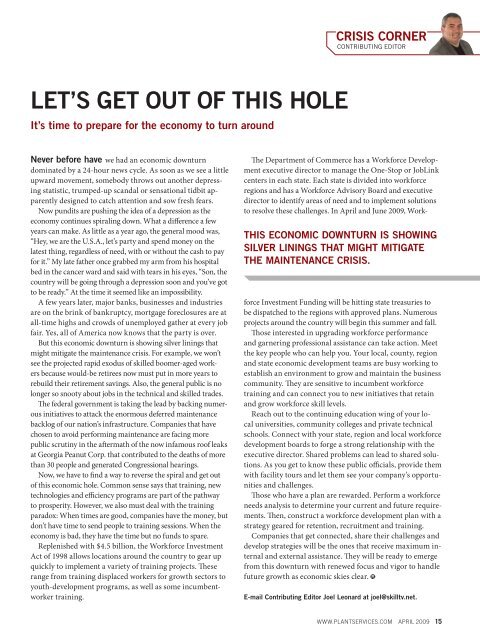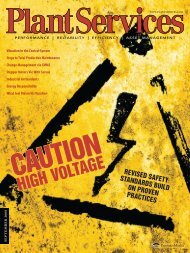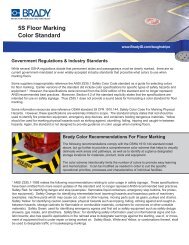POWER UP A WINNER - Plant Services
POWER UP A WINNER - Plant Services
POWER UP A WINNER - Plant Services
You also want an ePaper? Increase the reach of your titles
YUMPU automatically turns print PDFs into web optimized ePapers that Google loves.
Crisis COrner<br />
Contributing editor<br />
Let’s Get Out of This hOLe<br />
It’s time to prepare for the economy to turn around<br />
Never before have we had an economic downturn<br />
dominated by a 24-hour news cycle. As soon as we see a little<br />
upward movement, somebody throws out another depressing<br />
statistic, trumped-up scandal or sensational tidbit apparently<br />
designed to catch attention and sow fresh fears.<br />
Now pundits are pushing the idea of a depression as the<br />
economy continues spiraling down. What a difference a few<br />
years can make. As little as a year ago, the general mood was,<br />
“Hey, we are the U.S.A., let’s party and spend money on the<br />
latest thing, regardless of need, with or without the cash to pay<br />
for it.” My late father once grabbed my arm from his hospital<br />
bed in the cancer ward and said with tears in his eyes, “Son, the<br />
country will be going through a depression soon and you’ve got<br />
to be ready.” At the time it seemed like an impossibility.<br />
A few years later, major banks, businesses and industries<br />
are on the brink of bankruptcy, mortgage foreclosures are at<br />
all-time highs and crowds of unemployed gather at every job<br />
fair. Yes, all of America now knows that the party is over.<br />
But this economic downturn is showing silver linings that<br />
might mitigate the maintenance crisis. For example, we won’t<br />
see the projected rapid exodus of skilled boomer-aged workers<br />
because would-be retirees now must put in more years to<br />
rebuild their retirement savings. Also, the general public is no<br />
longer so snooty about jobs in the technical and skilled trades.<br />
The federal government is taking the lead by backing numerous<br />
initiatives to attack the enormous deferred maintenance<br />
backlog of our nation’s infrastructure. Companies that have<br />
chosen to avoid performing maintenance are facing more<br />
public scrutiny in the aftermath of the now infamous roof leaks<br />
at Georgia Peanut Corp. that contributed to the deaths of more<br />
than 30 people and generated Congressional hearings.<br />
Now, we have to find a way to reverse the spiral and get out<br />
of this economic hole. Common sense says that training, new<br />
technologies and efficiency programs are part of the pathway<br />
to prosperity. However, we also must deal with the training<br />
paradox: When times are good, companies have the money, but<br />
don’t have time to send people to training sessions. When the<br />
economy is bad, they have the time but no funds to spare.<br />
Replenished with $4.5 billion, the Workforce Investment<br />
Act of 1998 allows locations around the country to gear up<br />
quickly to implement a variety of training projects. These<br />
range from training displaced workers for growth sectors to<br />
youth-development programs, as well as some incumbentworker<br />
training.<br />
This eCONOmic downturn is showiNG<br />
silver liniNGs that might mitigate<br />
the maintenaNCe crisis.<br />
The Department of Commerce has a Workforce Development<br />
executive director to manage the One-Stop or JobLink<br />
centers in each state. Each state is divided into workforce<br />
regions and has a Workforce Advisory Board and executive<br />
director to identify areas of need and to implement solutions<br />
to resolve these challenges. In April and June 2009, Workforce<br />
Investment Funding will be hitting state treasuries to<br />
be dispatched to the regions with approved plans. Numerous<br />
projects around the country will begin this summer and fall.<br />
Those interested in upgrading workforce performance<br />
and garnering professional assistance can take action. Meet<br />
the key people who can help you. Your local, county, region<br />
and state economic development teams are busy working to<br />
establish an environment to grow and maintain the business<br />
community. They are sensitive to incumbent workforce<br />
training and can connect you to new initiatives that retain<br />
and grow workforce skill levels.<br />
Reach out to the continuing education wing of your local<br />
universities, community colleges and private technical<br />
schools. Connect with your state, region and local workforce<br />
development boards to forge a strong relationship with the<br />
executive director. Shared problems can lead to shared solutions.<br />
As you get to know these public officials, provide them<br />
with facility tours and let them see your company’s opportunities<br />
and challenges.<br />
Those who have a plan are rewarded. Perform a workforce<br />
needs analysis to determine your current and future requirements.<br />
Then, construct a workforce development plan with a<br />
strategy geared for retention, recruitment and training.<br />
Companies that get connected, share their challenges and<br />
develop strategies will be the ones that receive maximum internal<br />
and external assistance. They will be ready to emerge<br />
from this downturn with renewed focus and vigor to handle<br />
future growth as economic skies clear.<br />
E-mail Contributing Editor Joel Leonard at joel@skilltv.net.<br />
www.PLANTSERVICES.com APRIL 2009 15












